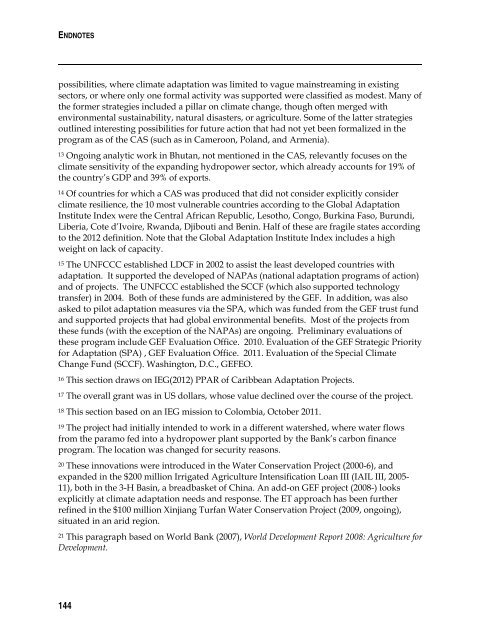Adapting to Climate Change: Assessing the World Bank Group ...
Adapting to Climate Change: Assessing the World Bank Group ...
Adapting to Climate Change: Assessing the World Bank Group ...
Create successful ePaper yourself
Turn your PDF publications into a flip-book with our unique Google optimized e-Paper software.
ENDNOTESpossibilities, where climate adaptation was limited <strong>to</strong> vague mainstreaming in existingsec<strong>to</strong>rs, or where only one formal activity was supported were classified as modest. Many of<strong>the</strong> former strategies included a pillar on climate change, though often merged wi<strong>the</strong>nvironmental sustainability, natural disasters, or agriculture. Some of <strong>the</strong> latter strategiesoutlined interesting possibilities for future action that had not yet been formalized in <strong>the</strong>program as of <strong>the</strong> CAS (such as in Cameroon, Poland, and Armenia).13 Ongoing analytic work in Bhutan, not mentioned in <strong>the</strong> CAS, relevantly focuses on <strong>the</strong>climate sensitivity of <strong>the</strong> expanding hydropower sec<strong>to</strong>r, which already accounts for 19% of<strong>the</strong> country’s GDP and 39% of exports.14 Of countries for which a CAS was produced that did not consider explicitly considerclimate resilience, <strong>the</strong> 10 most vulnerable countries according <strong>to</strong> <strong>the</strong> Global AdaptationInstitute Index were <strong>the</strong> Central African Republic, Lesotho, Congo, Burkina Faso, Burundi,Liberia, Cote d’Ivoire, Rwanda, Djibouti and Benin. Half of <strong>the</strong>se are fragile states according<strong>to</strong> <strong>the</strong> 2012 definition. Note that <strong>the</strong> Global Adaptation Institute Index includes a highweight on lack of capacity.15 The UNFCCC established LDCF in 2002 <strong>to</strong> assist <strong>the</strong> least developed countries withadaptation. It supported <strong>the</strong> developed of NAPAs (national adaptation programs of action)and of projects. The UNFCCC established <strong>the</strong> SCCF (which also supported technologytransfer) in 2004. Both of <strong>the</strong>se funds are administered by <strong>the</strong> GEF. In addition, was alsoasked <strong>to</strong> pilot adaptation measures via <strong>the</strong> SPA, which was funded from <strong>the</strong> GEF trust fundand supported projects that had global environmental benefits. Most of <strong>the</strong> projects from<strong>the</strong>se funds (with <strong>the</strong> exception of <strong>the</strong> NAPAs) are ongoing. Preliminary evaluations of<strong>the</strong>se program include GEF Evaluation Office. 2010. Evaluation of <strong>the</strong> GEF Strategic Priorityfor Adaptation (SPA) , GEF Evaluation Office. 2011. Evaluation of <strong>the</strong> Special <strong>Climate</strong><strong>Change</strong> Fund (SCCF). Washing<strong>to</strong>n, D.C., GEFEO.16 This section draws on IEG(2012) PPAR of Caribbean Adaptation Projects.17 The overall grant was in US dollars, whose value declined over <strong>the</strong> course of <strong>the</strong> project.18 This section based on an IEG mission <strong>to</strong> Colombia, Oc<strong>to</strong>ber 2011.19 The project had initially intended <strong>to</strong> work in a different watershed, where water flowsfrom <strong>the</strong> paramo fed in<strong>to</strong> a hydropower plant supported by <strong>the</strong> <strong>Bank</strong>’s carbon financeprogram. The location was changed for security reasons.20 These innovations were introduced in <strong>the</strong> Water Conservation Project (2000-6), andexpanded in <strong>the</strong> $200 million Irrigated Agriculture Intensification Loan III (IAIL III, 2005-11), both in <strong>the</strong> 3-H Basin, a breadbasket of China. An add-on GEF project (2008-) looksexplicitly at climate adaptation needs and response. The ET approach has been fur<strong>the</strong>rrefined in <strong>the</strong> $100 million Xinjiang Turfan Water Conservation Project (2009, ongoing),situated in an arid region.21 This paragraph based on <strong>World</strong> <strong>Bank</strong> (2007), <strong>World</strong> Development Report 2008: Agriculture forDevelopment.144

















